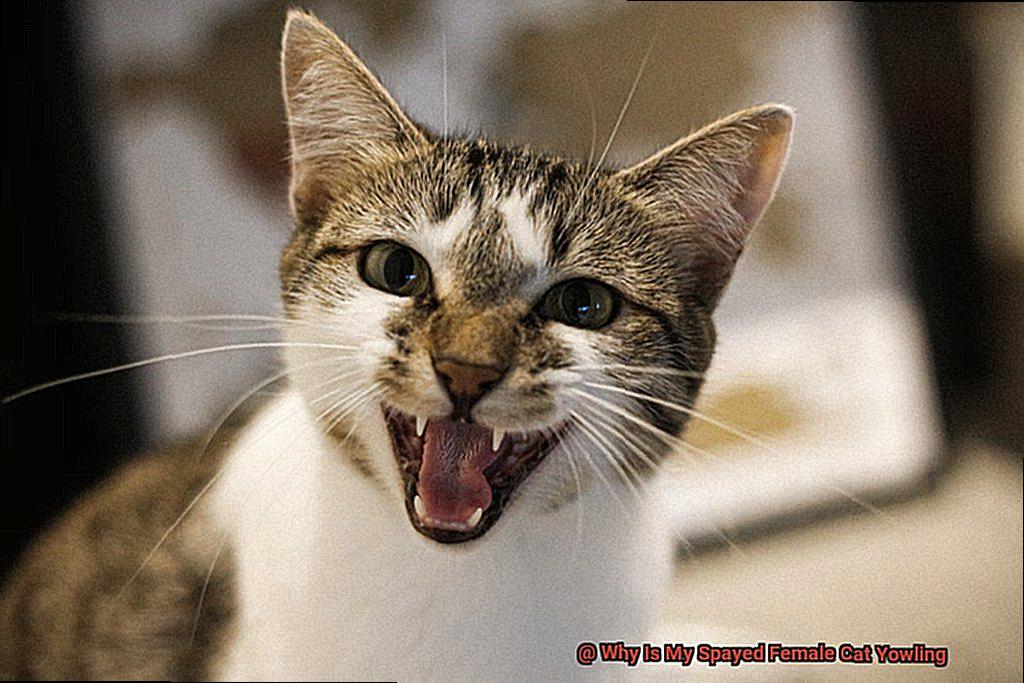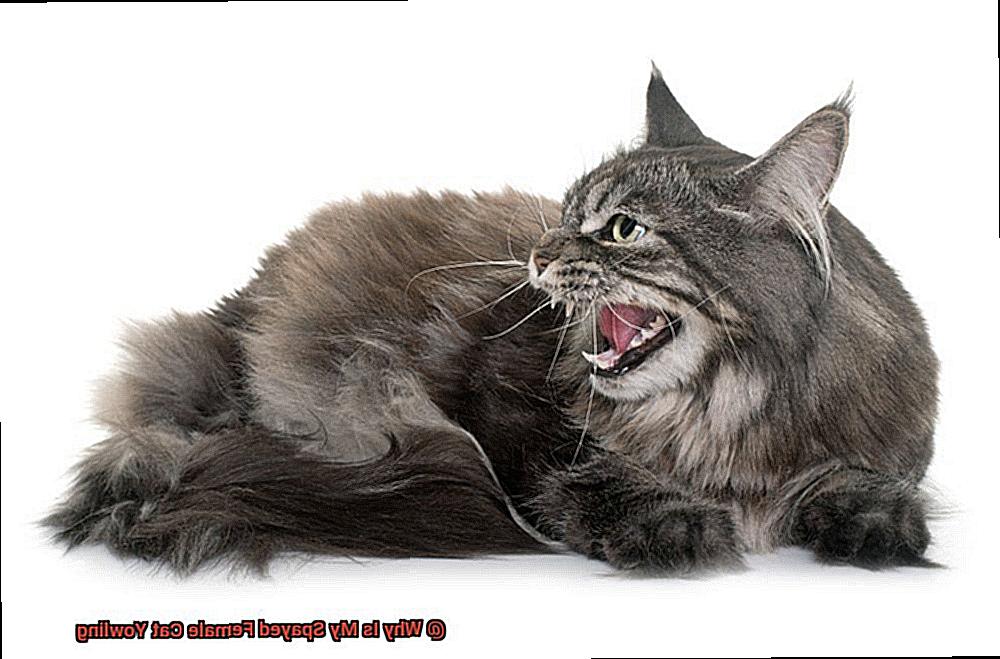Have you ever heard your spayed female cat yowling and wondered why? It can be perplexing and even frightening. Cats are known to be vocal, but there could be something else going on.
It’s important to know what’s causing your spayed female cat to yowl so that you can help her feel better. In this blog post, we’ll discuss the reasons why your spayed female cat may be yowling and how you can help her get out of whatever is bothering her.
There are several potential causes of yowling in cats, ranging from medical conditions such as pain or infection to psychological disorders such as loneliness or anxiety. We’ll explore all of these possibilities and give tips on how you can help your feline friend if she’s sick or stressed out.
You don’t have to deal with the mystery any longer. With this blog post, you’ll learn what’s causing her anxiety and how to make her feel better. So let’s dive in and see all the potential explanations for your spayed female cat’s yowling.
Medical Issues as a Cause of Yowling
If so, it could be a sign of an underlying medical condition. Yowling is one of many cat behaviors that can be concerning for owners, and it can be worrying to hear your cat vocalizing in pain or discomfort. While spaying may reduce some of the behaviors associated with heat cycles in female cats, it does not necessarily mean that all such behaviours will cease if your cat has a medical issue.
Medical conditions that can cause yowling in spayed female cats include urinary tract infections (UTIs), bladder stones, blockages, arthritis, dental problems, and hyperthyroidism.
UTIs and bladder stones can cause pain and make your cat yowl. Arthritis is a common condition in older cats which can lead to pain and stiffness in joints, making it difficult for them to move or jump.
Dental problems such as gum disease or tooth decay can also cause pain and discomfort, leading to yowling. Hyperthyroidism is a condition that occurs when the thyroid gland produces too much hormone, resulting in an overactive metabolism with weight loss, excessive thirst, and increased vocalization including yowling.
It is essential to take your cat to a veterinarian regularly for checkups and cleanings. If you suspect your cat has any of these medical conditions, seek treatment as soon as possible.

Early detection and intervention will help your furry friend recover quickly and prevent more problems from occurring down the road.
Stress and Anxiety as a Cause of Yowling
Yowling in spayed female cats can often be a sign of stress or anxiety. If your cat is exhibiting this behavior, it is important to identify the root cause and take steps to alleviate it.
Creating a safe and secure environment for your cat is essential for reducing stress. This means providing a designated area for your cat to retreat to, such as a cat tree or cozy bed, as well as plenty of toys and scratching posts.
Additionally, spending quality time with your cat each day can help build the bond between you and reduce feelings of anxiety or detachment.
In some cases, medications or pheromone sprays may be necessary to help manage a cat’s stress or anxiety. If you believe that yowling is related to stress or anxiety, consulting with a veterinarian or feline behavior specialist is highly recommended in order to find the best solution for your pet.
Attention-Seeking Behavior as a Cause of Yowling
Yowling in spayed female cats is often a result of attention-seeking behavior. To help your cat reduce her stress and anxiety, there are several steps you can take. Firstly, provide your cat with a safe and comfortable space.
Make sure she has access to plenty of food and water throughout the day, as well as a cozy place to sleep. Secondly, give your cat lots of love and affection.
Spend quality time with her every day, cuddle her, and scratch behind her ears – she’ll appreciate it. Lastly, provide stimulating toys that will keep her active and entertained.
Signs and Symptoms to Look Out For
Cat owners should be aware of the potential signs and symptoms of cat yowling, especially in spayed females. While spaying may reduce some of the behaviour associated with heat cycles, it does not guarantee that all such habits will be eliminated.
A change in vocalization is a telltale sign of excessive meowing; if your usually quiet cat starts yowling loudly and incessantly, something could be wrong. Other signs include decreased appetite or loss of interest in their favorite activities, as well as aggression, restlessness, or overly affectionate behaviour.
Female cats who yowl persistently may also display physical symptoms such as pacing, hunger, or hyperactivity. They may squat frequently as if trying to urinate, which could indicate a urinary tract infection. Cats suffering from digestive problems may vomit or have diarrhea around the house.

If any of these signs are present in your cat, it is important to seek veterinary assistance immediately to ensure that any underlying health conditions are addressed and handled properly.
Additionally, creating a warm sanctuary for your pet with a variety of toys and treats can help reduce anxiety levels and eliminate attention-seeking behaviour which can lead to excessive meowing.

Diagnosis and Treatment Options for Medical Conditions
If your spayed female cat is yowling, it’s important to investigate underlying medical issues. A visit to the veterinarian for a thorough physical exam and blood tests may be necessary in order to rule out any potential conditions.

Hyperthyroidism is one of the most common medical conditions that can cause yowling in spayed female cats. Treatment for this condition typically includes medication, surgery, or radioactive iodine therapy, depending on the severity.
Urinary tract infections are also a common issue that can cause pain and discomfort in cats, and antibiotics are often used to treat this condition.
In some cases, there may not be an underlying medical issue causing the yowling. If this is the case, consulting with a behaviorist or veterinarian can help identify any behavioral causes and develop an effective treatment plan.
Ways to Reduce Stress in Cats
It may be time to discover the source of her distress and take action to reduce it. Cats can become stressed for many reasons, such as changes in their environment, routine, or due to anxiety. Here are seven ways to help your kitty feel calm and secure.
First and foremost, cats need a tranquil and secure environment. Create a cozy bed, toys, and a scratching post for your cat to enjoy. You can also use a pheromone diffuser such as Feliway for an extra calming effect.
Additionally, establish a routine for your cat that includes feeding, playing, and sleeping at the same times each day. This predictability will make them feel more relaxed and content.
Playtime is also essential for cats because it helps them release pent-up energy and reduce stress. Set aside time every day to play with your spayed female cat, offering her different toys to keep her mentally stimulated.
Furthermore, provide hiding spots in your house where she can retreat when she needs some alone time.
Also be mindful of what she eats since certain foods or additives can cause stress in cats. Feed her high-quality food without any potential triggers that could cause anxiety.
Furthermore, minimize exposure to loud noises by keeping music or TV volume low and taking steps to muffle any sound coming from outside your home. Finally, if yowling persists despite these efforts, visit the vet to rule out any underlying medical condition or injury causing the behavior.
How to Handle Attention-Seeking Behavior
Fortunately, there are several strategies you can use to minimize or even eliminate the behavior.
The first step is to rule out any underlying medical condition that may be causing your cat’s behavior. If your cat is in pain, for example, she may be meowing or yowling as a way of indicating that she needs help.
If you’re uncertain if your cat’s behavior is medically related, it’s always wise to take her to a veterinarian for a checkup.
Assuming that your cat is healthy, there are several ways to manage her attention-seeking behavior. One approach is to provide plenty of interactive toys so that she can keep herself entertained when you’re not around.
You might also consider setting up a perch or window seat near a window so that your cat can watch birds or other wildlife outside.
Establishing a consistent routine, such as feeding at the same time each day and regular playtime sessions, will also reassure your cat that she’ll always receive the attention she needs – even if it’s not on demand.
If your cat continues to yowl for attention despite all these efforts, it’s important to avoid reinforcing the pattern by giving her extra attention when she does so. Instead, wait until she’s quiet before providing her with any affection or treats.
5dMTK-DqmYM” >
Tips for Cat Owners on Dealing with Yowling
Yowling is a common occurrence among cats, but cat owners may find it concerning. Even after being spayed, female cats can yowl for a variety of reasons. If your cat is yowling, it’s important to understand the cause and take steps to address it. Here are some tips for dealing with yowling in your spayed female cat.
First and foremost, determine the source of your cat’s yowling. It could be due to attention-seeking behavior, medical conditions, anxiety, or territorial disputes. Once you identify the cause, you can take action to resolve it.
Enrichment activities such as toys and scratching posts can help keep your cat engaged and prevent boredom-induced yowling. Additionally, increasing interaction with your cat will provide them with the attention they need and reduce their vocalization.
If you suspect that your cat’s yowling is due to a medical condition, make sure you schedule a visit to the vet as soon as possible. Conditions such as hyperthyroidism or urinary tract infections can have serious repercussions if left untreated.
Creating a peaceful and calming environment will also help reduce yowling caused by stress or territorial disputes. Providing each cat with their own space or hiding spot can minimize conflict between cats, while pheromone diffusers or calming collars can help reduce anxiety in cats.
Lastly, refrain from reinforcing yowling behavior by ignoring or redirecting your cat’s attention when they vocalize excessively.
Also Read: How To Stop A Cat In Heat From Meowing? – 21Cats.org
Conclusion
When your spayed female cat yowls, it can be perplexing and even frightening. But, understanding the potential causes of her distress can help you provide her with the care she needs. Yowling could be due to many things, from urinary tract infections to hyperthyroidism to anxiety and fear.
Fortunately, there are steps you can take to reduce yowling in your spayed female cat. Offer a safe and secure environment filled with scratching posts for entertainment. Spend quality time with her daily, instill positive habits and stick to a consistent routine – all of which will help reduce stress levels and eliminate attention-seeking behavior that leads to excessive meowing.
If you suspect your cat’s yowling is due to a medical condition, don’t delay seeking veterinary assistance. Early detection and intervention can help your furry friend recover quickly and prevent more problems from occurring down the road.

